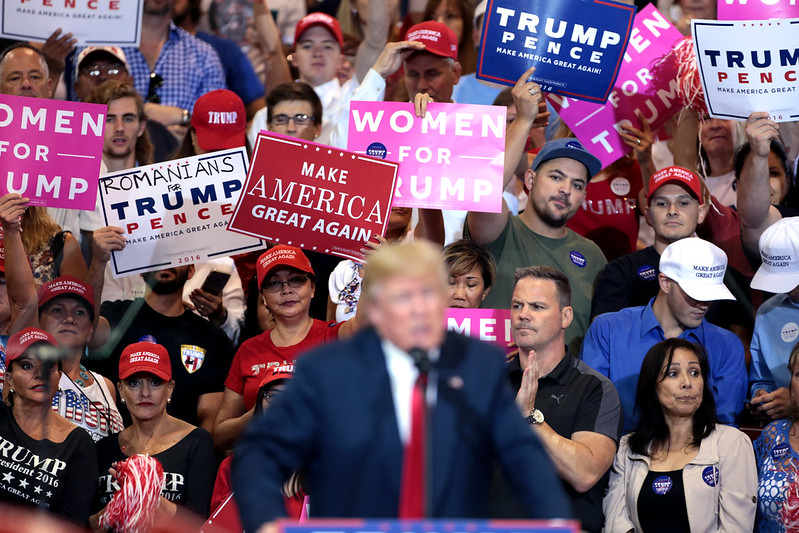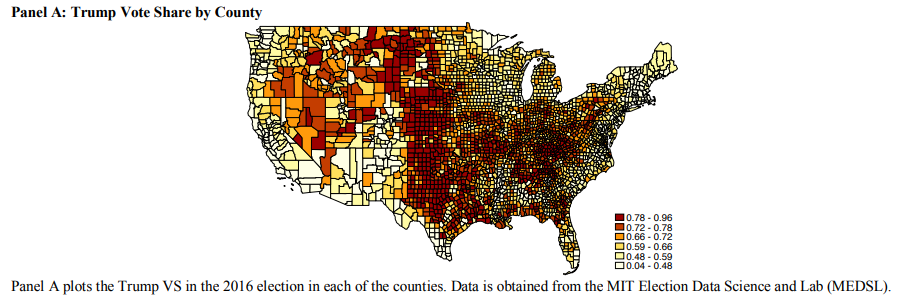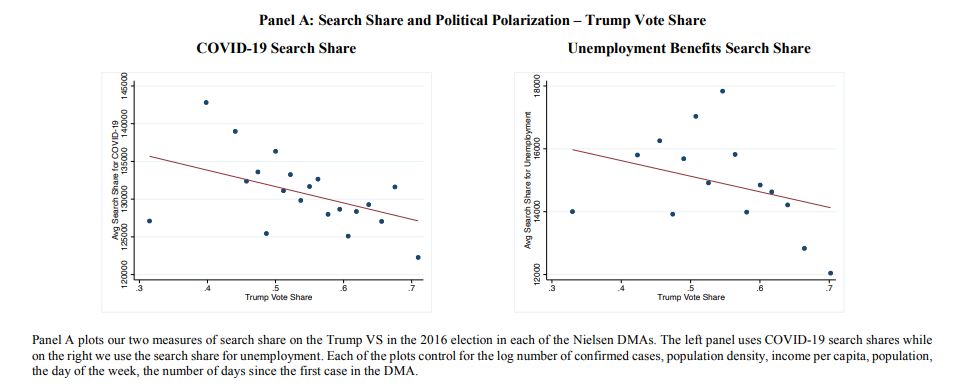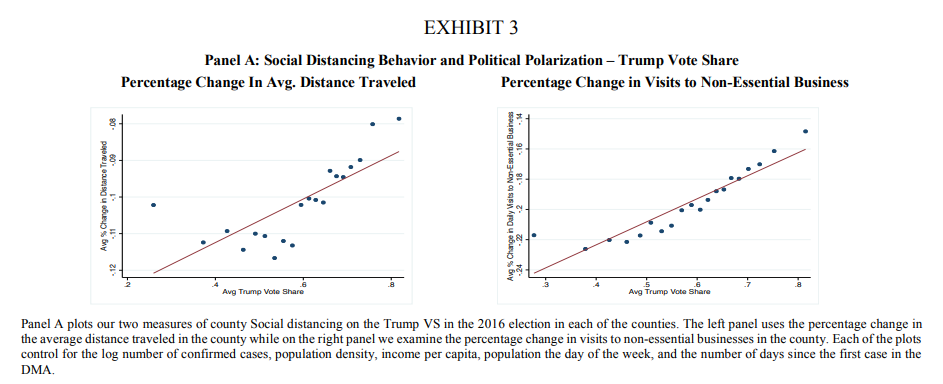Using data on individuals’ search behavior and cellphone movement data, a new study shows that areas with a high share of Trump voters began to worry about the Covid-19 outbreak only after prominent Republicans like Ted Cruz got infected. Trump supporters were also reluctant to respect social distancing until they received guidelines directly from the White House.

Even when, objectively speaking, death is on the line, partisan bias still colors beliefs about facts.
Using novel data on individuals’ search behavior on Google and geospatial data capturing changes in individuals’ daily travel distance and trips to non-essential businesses and service locations, we document a significant divergence in the reactions to Covid-19 cases across high and low Trump vote share areas in the 2016 election.
Specifically, we document a muted response to preliminary Covid-19 incidents in high Trump vote share areas—even as state governments imposed a variety of school and business closures and stay-at-home recommendations.
High Trump areas catch-up in Covid-19 attention only after prominent Republican figures were quarantined following the announcement of their exposure to Covid-19 at the annual Conservative Political Action Conference (CPAC) meeting.
In a pandemic, an individual’s risk of infection is determined by both their own behavior and that of others who may perceive risks differently. Because of these externalities, public health outcomes hinge critically on how different populations perceive risk in response to objective data and how they respond to suggested courses of action such as social distancing.
We explore the effects of political partisanship on two sets of measures: measures of risk perception (online search behavior for information about (i) the virus, and (ii) unemployment benefits) and measure of actual conduct (social distancing behavior, in the form of the percentage change in daily distance, traveled and in visits to non-essential businesses).
Data for the former is obtained from Google Health Trends, and for the latter from Unacast, a location data products company that utilizes cellphone movement data.
We proxy for political polarization by using the share of voters in the county who voted for Donald J. Trump in the 2016 presidential election.
While search share for both types of terms (the virus, and unemployment benefits) is increasing in the number of confirmed cases announced, the increase is muted significantly in counties with higher Trump vote share, holding all else equal.
Consistent with a difference in risk perceptions, search share for Covid-19 terms increases sharply in low Trump voter share counties surrounding the first case of Covid-19 in the county, relative to high Trump voter share counties. They reverse their pattern only surrounding the first confirmed death from Covid-19 in the county, with high Trump vote share counties playing catch up only once deaths are imminent.
Social Distancing
Turning to social distancing behavior, consistent with individuals taking cases of Covid-19 seriously, we observe increases in social distancing behavior as a function of the number of confirmed. However, once again, this effect is muted in higher Trump voter share counties where changes in daily distance traveled, and visits to non-essential businesses are higher when compared to the low Trump vote share areas.
Over the course of the pandemic, state governments issued various directives regarding the closure of non-essential businesses and schools and “stay home-work safe” (shelter-in-place). Furthermore, on March 16th, federal guidelines for social distancing for a 15-day period were announced.
Using the variation within state across counties in Trump voter share, and show that compliance with such directives varies substantially across high (Q4) and low (Q1) Trump voter share counties.
We show that in high Trump voter share counties there is a significantly lower reduction in both average daily distance traveled and in visits to non-essential businesses, given the same directive in the same state, and holding county characteristics fixed. When the federal guidelines are issued by the White House, in contrast, high Trump voter share areas actively increase their response, catching up to other area’s prior social distancing behavior.
The Republican Catch-Up
Consistent with the hypothesis that political priors color interpretation of objective data, we show that these patterns shift considerably once Republican politicians begin to be affected by the pandemic.
Specifically, following the announcement on March 9th that an individual at the CPAC tested positive for Covid-19 leading to the self-quarantining of several prominent Republicans, including Senator Ted Cruz, high Trump voter share counties shift their behavior, reducing the distance traveled and visits to non-essential businesses more in response to confirmed cases.
In essence, the high Trump areas begin to play catch-up: low Trump share counties, who already had reduced daily distance and non-essential visits considerably, continue to increase their level of social distancing as cases rise; high Trump voter share counties now do so at an even higher rate, roughly twice the magnitude of the continued reductions in low Trump voter share counties.
Moreover, when we map risk perceptions and responses before and after the CPAC announcement to the 2019 ratio of Google search share for Fox News to the search-share for MSNBC in the area, we observe that responses across the media ratio are much higher after the March 9th CPAC announcement. Particularly for the risk perception measures, the higher Fox News areas now search significantly more than the low Fox News areas.
We end our analysis by exploring the relationship between our risk perception and social distancing measures and Trump voter share for varying levels of a high-risk population (percentage of the population over age 60) and one’s ability to work from home.
In both cases, we observe higher search share and greater social distancing were expected: when the share of the population over the age of 60 is higher, and in areas where the percentage of employment that can be done via telework is higher. Even so, holding these elements constant, we continue to observe the divergence in response between high and low Trump vote share counties.
As countries across the world struggle to contain the spread of the virus and lessen the possibility of significant deaths and prolonged economic contraction, understanding how individuals and households react to information treatments and voluntary compliance measures becomes of ever more critical to the ultimate resolution of the current crisis.
Our findings suggest that risk perceptions and—consequently—behavioral choices are shaped by the lens of politics, rendering interventions that rely on a uniform interpretation of the risk associated with the outbreak less effective if these interventions don’t come with clear, bipartisan, and consistent communication.
John M. Barrios is an Assistant Professor of Accounting at the University of Chicago, Booth School of Business. Yael Hochberg is the Ralph S. O’Connor Professor in Entrepreneurship at Rice University and head of the Rice University Entrepreneurship Initiative. You can find the working paper here.
ProMarket is dedicated to discussing how competition tends to be subverted by special interests. The posts represent the opinions of their writers, not necessarily those of the University of Chicago, the Booth School of Business, or its faculty. For more information, please visit ProMarket Blog Policy.








